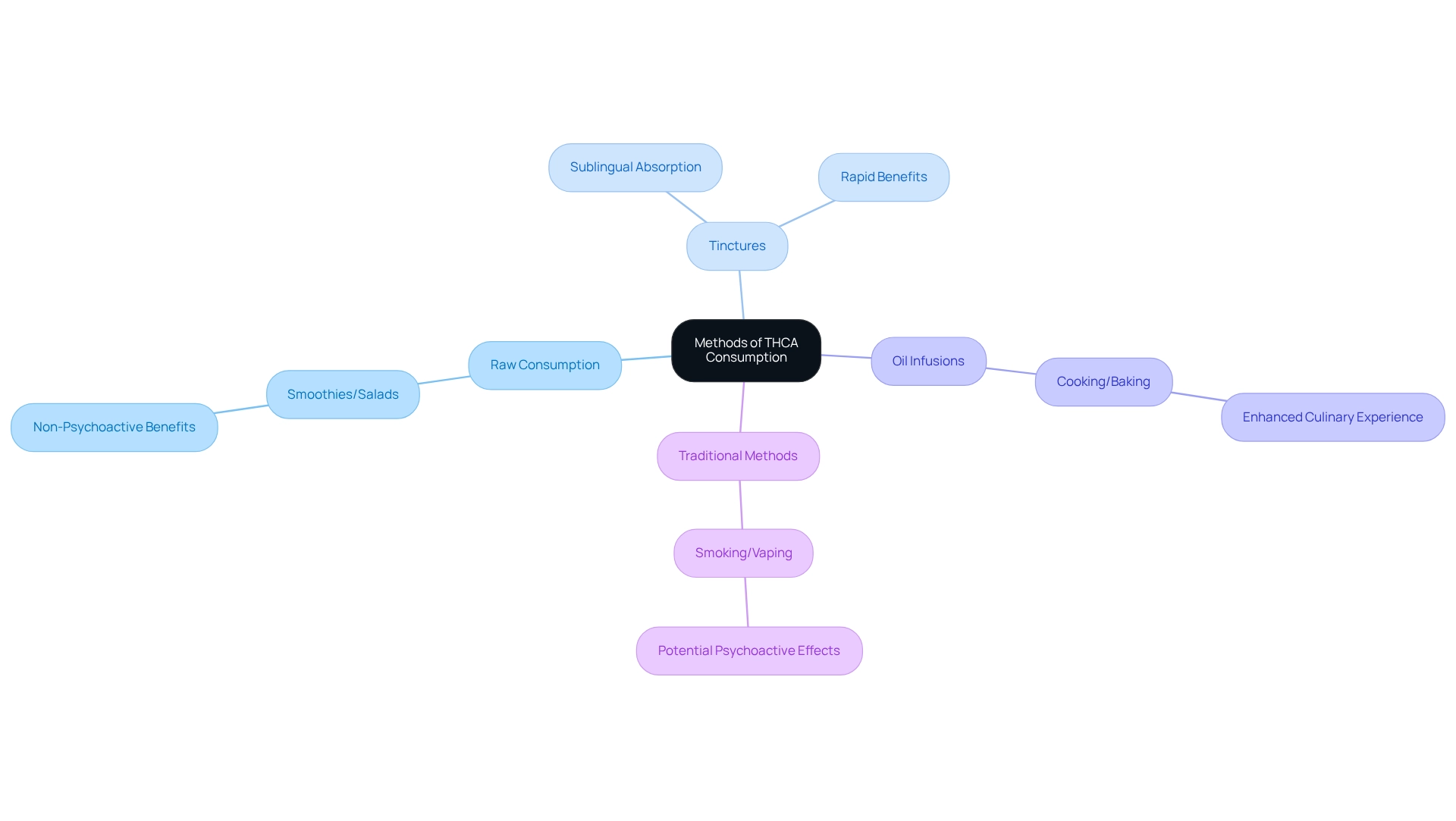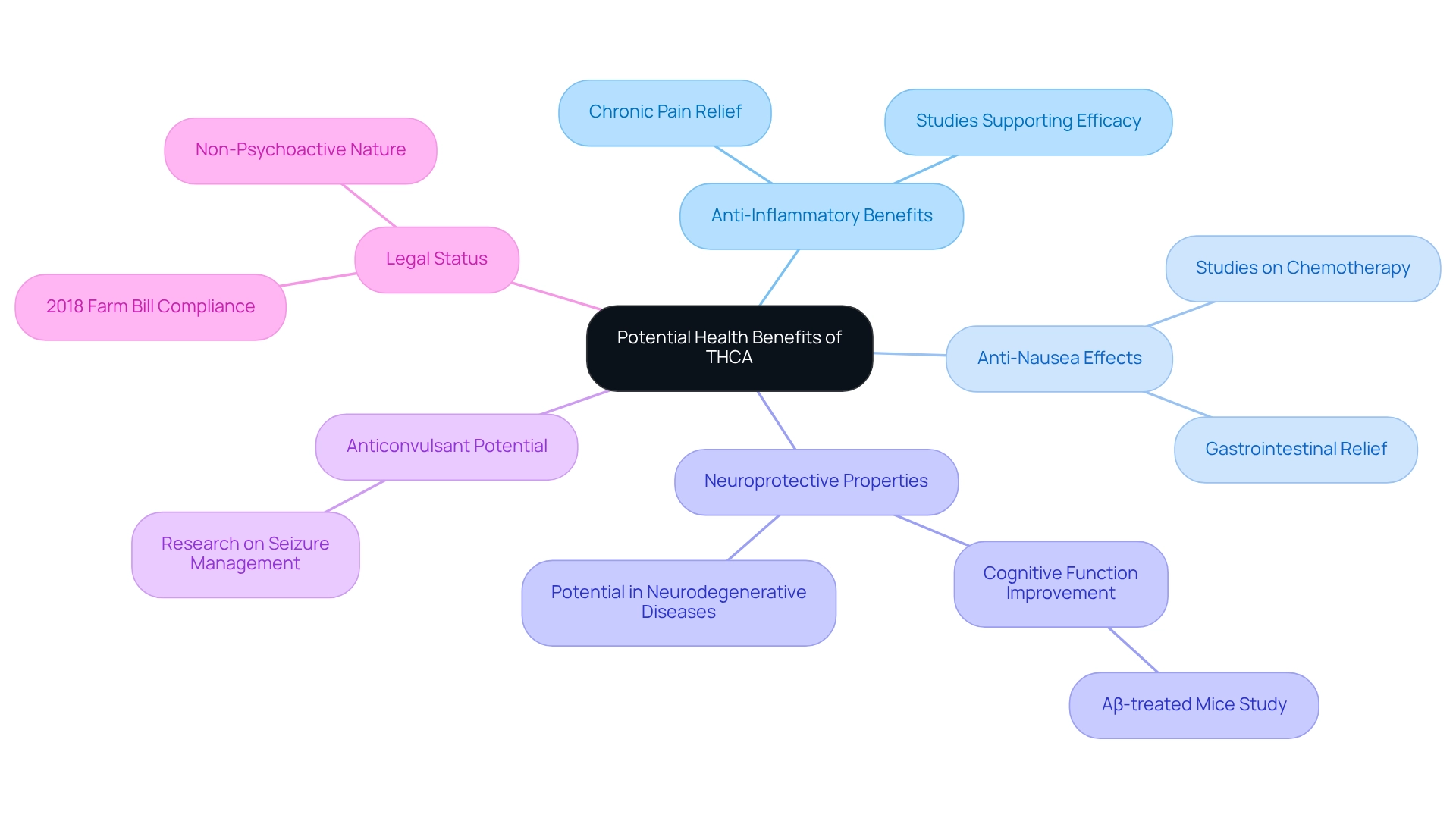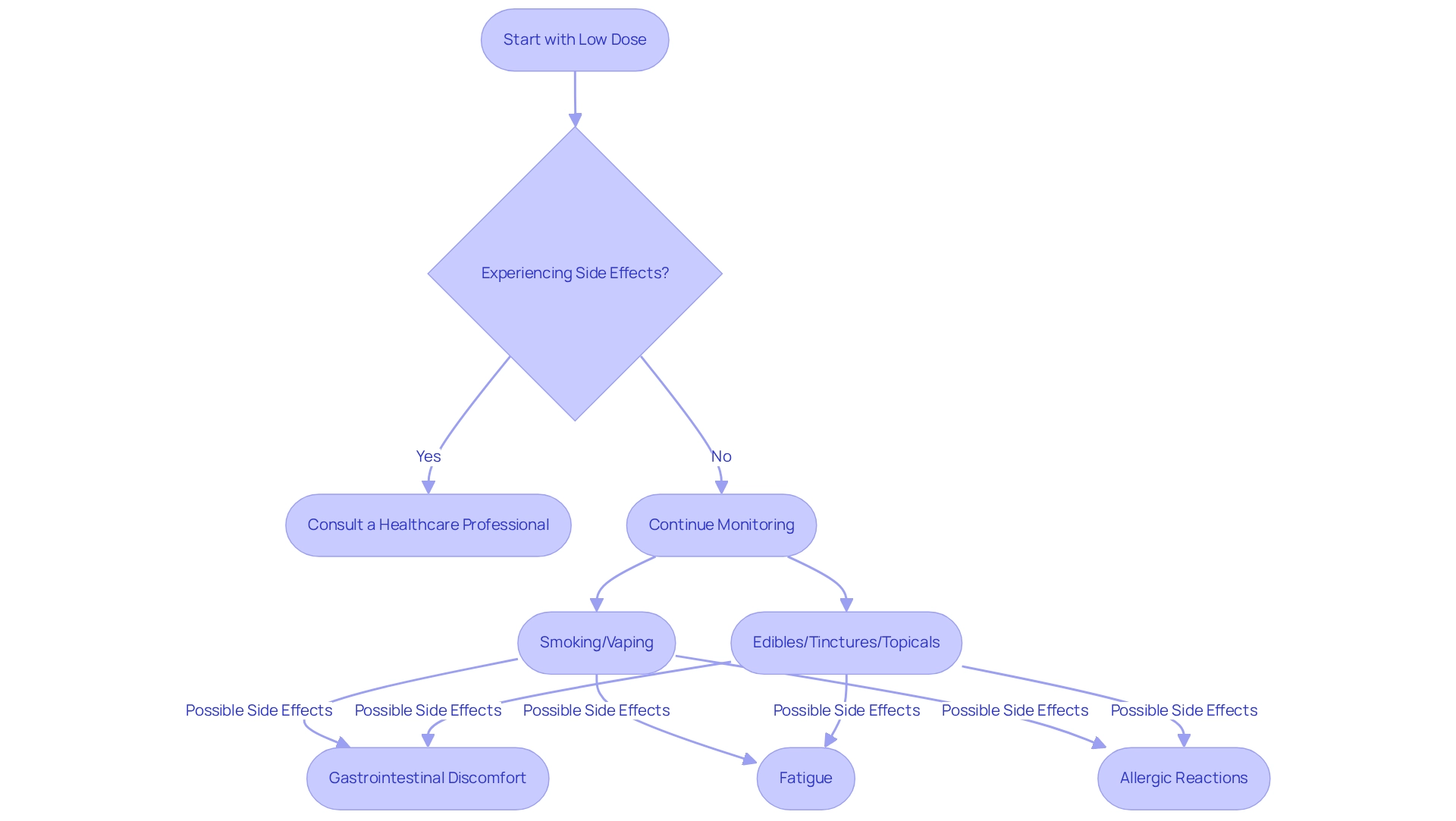
Understanding THCA Effects: A Complete Tutorial on Its Benefits and Uses
Share
Overview
THCA (tetrahydrocannabinolic acid) isn’t just another cannabinoid; it’s a game-changer. Picture this: anti-inflammatory, neuroprotective, and anti-emetic properties wrapped in a package that won’t send you spiraling into a THC haze. For those craving relief without the high, THCA stands as a beacon of hope.
Imagine managing chronic pain and nausea with a substance that enhances your wellness without clouding your mind. The allure of non-psychoactive cannabinoids is growing, and consumers are tuning in. Are you ready to explore this seductive world where relief meets clarity?
Dive into the depths of cannabis culture, where the whispers of THCA beckon you to discover its therapeutic treasures. What are you waiting for? Embrace the journey and unlock the potential that lies within this extraordinary compound.
Introduction
In the shadowy corners of the cannabis world, THCA (tetrahydrocannabinolic acid) emerges as a tantalizing non-psychoactive cannabinoid, capturing the gaze of wellness seekers and researchers alike. Unlike its notorious sibling THC, THCA sidesteps the euphoric highs that often accompany cannabis, making it a seductive choice for those craving therapeutic benefits without the intoxicating haze. As research unveils its potential in realms like anti-inflammation, neuroprotection, and energy metabolism, the allure of THCA products surges.
With trailblazers like Darc Arts at the forefront, consumers are beckoned to uncover the distinct advantages of THCA while weaving wellness into a tapestry of gothic elegance. This article plunges into the intricate universe of THCA, dissecting its composition, effects, consumption methods, and the broader implications for health and lifestyle.
What is THCA? An Overview of Its Chemical Composition
Tetrahydrocannabinolic acid—a non-psychoactive cannabinoid lurking in raw cannabis—serves as the precursor to THC. When heat hits it through smoking or cooking, it morphs into THC. This compound flaunts a carboxylic acid group (COOH), a defining feature that sets it apart from its psychoactive counterpart, THC, which lacks this group.
This unique chemical makeup is crucial; it bars tetrahydrocannabinolic acid from binding to cannabinoid receptors in the brain, stripping away the psychoactive effects typically associated with THC.
Richly embedded in fresh marijuana blooms, this compound is a treasure trove for the healing potential of unprocessed marijuana products. Recent studies spotlight its benefits, showcasing its prowess in enhancing mitochondrial biogenesis in neuronal cells. Research reveals that Δ-THCA can significantly pump up mitochondrial mass and up-regulate PGC-1α expression, hinting at its positive influence on cellular energy metabolism.
This revelation underscores the compound's promise in wellness applications, solidifying its status as a vital player in the cannabis realm. Phillip S Grant from the School of Chemical Sciences, University of Auckland, asserts, "The therapeutic properties of this compound are becoming increasingly acknowledged, especially concerning energy metabolism and overall wellness."
As the appetite for non-psychoactive cannabinoids surges, this compound emerges as a beacon for those seeking therapeutic benefits devoid of intoxicating THC effects. It's the perfect ally for individuals craving natural relief and enhanced mental clarity. With a commitment to quality, Dark Arts ensures that its Hybrid Pre-Rolls are crafted from 100% premium indoor trim, allowing consumers to indulge in the full spectrum of THCA's advantages safely and effectively.
Each pack boasts 5 premium Hybrid Pre-Rolls, priced at $49.99 USD. Moreover, research suggests that the Δ-THC/THCA or CBD/CBDA ratio can serve as a marker for evaluating the quality and shelf-life of cannabis-derived products, emphasizing the significance of tetrahydrocannabinolic acid in product formulation. In this light, this compound not only embodies the essence of cannabis wellness but also aligns seamlessly with the gothic elegance defining the Dark Arts lifestyle, beckoning enthusiasts to delve into the transformative powers of this substance for creativity and wellness.
Add to cart or purchase now to unlock the unique advantages of our Hybrid Pre-Rolls.
Exploring the Effects of THCA on the Body: Therapeutic Benefits and Mechanisms
This compound is not just emerging; it’s a force to be reckoned with, boasting a repertoire of therapeutic advantages—anti-inflammatory, neuroprotective, and anti-emetic characteristics that are hard to ignore. Imagine a world where the agonies of arthritis and nausea fade into the background, all without the haze of THC. Studies reveal that this compound’s anti-inflammatory prowess can slice through pain and swelling, offering a natural remedy for those ensnared in chronic pain's grip.
But wait, there’s more. Beyond its anti-inflammatory magic, this compound may serve as a guardian for your brain cells, a beacon of hope against neurodegenerative diseases like Alzheimer’s. When every moment counts, preserving cognitive function becomes paramount. Recent revelations suggest cannabinoids, including tetrahydrocannabinolic acid, might just be the key to unlocking the mysteries of the microbiota-gut-brain axis, paving the way for groundbreaking strategies against neuroinflammatory diseases.
This connection isn’t just a whisper; it’s a shout about the compound’s potential to elevate brain health and wellness to new heights.
Statistics don’t lie—95.9% of participants in a cancer study reported a surge in health following cannabinoid treatment. This isn’t just a trend; it’s a revolution in therapeutic applications. As the cannabis research landscape morphs, tetrahydrocannabinolic acid’s advantages are stepping into the limelight, with experts rallying behind its medical applications. Jin-Chul Kim stands at the forefront, championing cannabinoids and solidifying their place in the therapeutic realm.
What lies ahead in 2025? The ongoing investigation into this compound’s effects promises to unveil deeper insights into its role in wellness and symptom relief. Enter Darc Arts—a brand that embodies this commitment to wellness through high-quality cannabis products. They invite you to experience the profound benefits of this compound, all while embracing a lifestyle that intertwines gothic elegance with holistic health. This isn’t just a brand; it’s a movement that celebrates cannabis’s healing potential, as illustrated in the case study 'Darc Arts as a Lifestyle,' showcasing a community that revels in wellness and gothic aesthetics.

THCA vs. THC: Key Differences and Implications for Use
The fundamental distinction between tetrahydrocannabinolic acid and THC? It's all about the psychoactive properties. Tetrahydrocannabinolic acid, or THCA for those in the know, is non-psychoactive—meaning no euphoric effects that THC lovers crave. This makes it a magnet for those seeking the therapeutic benefits of cannabis without the intoxicating haze.
But heat changes the game. When THCA meets warmth, it undergoes decarboxylation, morphing into THC. This transformation is what hooks THC to the CB1 receptors in the brain, unleashing that signature 'high' that many users chase.
This differentiation is vital for wellness warriors. THCA is stepping into the spotlight, recognized for its potential health perks—think anti-inflammatory powers and relief from ailments like arthritis, nausea, and neurodegenerative disorders. Cannabis flower and pre-rolls, heavy on THCA, are now available for those eager to reap the benefits without the THC effects. Many consumers are turning to this compound for natural relief, sidestepping the THC buzz while still easing discomfort, sharpening mental clarity, and promoting relaxation.
The rising interest in non-psychoactive cannabis has sparked innovative consumption methods. THCA can be enjoyed in fresh plant juices, tinctures, or even raw in smoothies and salads, allowing users to tap into its therapeutic potential flexibly. As the cannabis landscape shifts, understanding the nuances between THCA and THC is becoming crucial.
With a focus on wellness and a craving for natural relief, consumers are gravitating toward THCA options, offering a unique blend of benefits without the THC effects. This trend mirrors a broader movement in the cannabis market, where the demand for non-psychoactive alternatives continues to surge, catering to those who value the plant's therapeutic potential while maintaining clarity and focus. As K. Verhoeckx points out, exploring these compounds is key to unlocking their full wellness potential.
Yet, a word of caution for consumers: be aware of safety warnings regarding THC sensitivity. If THC makes you uneasy, tread lightly and consult a doctor before diving in. Darc Arts embodies this lifestyle shift, cultivating a distinctive identity that resonates with consumers seeking more than just cannabis products.
Methods of Consumption: How to Use THCA Effectively
The non-psychoactive compound beckons, inviting exploration through various consumption methods, each unveiling distinct advantages and experiences that resonate with its healing prowess. Picture this: raw marijuana flowers, seamlessly blended into smoothies or salads, allowing users to tap into the therapeutic essence of tetrahydrocannabinolic acid. It’s an alluring option for those chasing wellness without the haze of psychoactive effects.
Recent studies reveal a tantalizing truth—THCA-A flourishes within the embrace of herbal cannabis, shielded by the protective allure of terpenoids. This revelation amplifies the allure of raw consumption methods, a testament to nature’s quiet magic.
Then there are tinctures—an elegant, effective way to consume cannabinoids. Extracted and savored sublingually, they promise rapid absorption into the bloodstream, maximizing benefits. This method embodies the alchemy of wellness that Darc Arts champions, akin to the subtle sorcery behind natural relief.
For the culinary adventurers, infusing this compound into oils for cooking or baking transforms everyday meals into high-quality experiences. It’s not just about taste; it’s about savoring the beneficial effects in a delightful dance, echoing the gothic sophistication that defines Darc Arts.
Of course, traditional methods like smoking or vaping cannabis flower still hold sway. But beware—the transformation of some compounds into THC a effects may not align with the desires of those who seek the non-psychoactive advantages of THC a effects. It’s a choice, a path diverging in the smoky haze.
As cannabis acceptance blooms—54% of Americans now dwell in states where recreational use is embraced, according to the Pew Research Center—understanding these varied consumption methods becomes essential. It’s about maximizing benefits and weaving cannabis into a holistic wellness tapestry. The case study, "Darc Arts: More Than Just a Product," reveals how Darc Arts cultivates a community around its offerings, inviting consumers to embrace a narrative that honors both wellness and gothic elegance.

Potential Health Benefits of THCA: What Research Shows
Investigations into tetrahydrocannabinolic acid are unearthing a treasure trove of potential health benefits that are stirring up the medical community. This compound? It's got anti-inflammatory magic, a beacon of hope for those wrestling with chronic pain. Imagine finding relief without the THC effects that come with the usual psychoactive suspects.
And there's more—its anti-nausea prowess shines, especially for those battling through chemotherapy or gastrointestinal woes. Research is showing that this compound can significantly cut down nausea, offering a natural remedy for those in distress. Recent studies? They underscore its effectiveness in managing nausea, cementing its place in the therapeutic realm.
But wait, there's a twist. Preliminary findings hint at neuroprotective effects, potentially staving off neurodegenerative diseases. This is the kind of revelation that sets the stage for deeper dives into its long-term health perks. Picture this: a study with Aβ-treated mice revealed that treatment with the compound ramped up the number of crossings, signaling boosted cognitive function (p = 0.044).
As if that weren't enough, this compound is also being eyed for its anticonvulsant properties, layering on yet another dimension to its therapeutic profile. With research forging ahead, the potential uses of this compound are gaining recognition, marking it as a key player in the natural wellness arena. It’s not just about easing chronic pain and nausea; it’s about igniting curiosity into its myriad health advantages, perfectly aligning with the ethos of Darc Arts and its mission to elevate wellness through premium cannabis products.
But hold on—let's talk legality. The 2018 Farm Bill defines this compound as industrial hemp, akin to CBD and CBG. That means tetrahydrocannabinolic acid is on the legal side of things, as long as it keeps under 0.3% Delta-9 THC on a dry-weight basis. Navigating cannabis laws can be a maze, and understanding this legal framework is vital for consumers.
Now, let’s get into the nitty-gritty of THC effects. While they share a connection, they’re not the same. The compound is non-psychoactive in its raw form, needing decarboxylation—typically through heating—to morph into THC, unleashing those psychoactive effects. This transformation is crucial; it shapes how these compounds dance with the body’s neuroreceptors.
As showcased in the case study "Darc Arts as a Lifestyle," the brand cultivates a community vibe, enriching the narrative of its lifestyle approach. The dedication of researchers in this domain deserves a shout-out too. A nod to the professionals at Shanghai Chempartner (China) and Pharmaseed Ltd. (Israel) for their meticulous efforts in this study. Their collective drive emphasizes the importance of ongoing research in unlocking the mysteries and advantages of tetrahydrocannabinolic acid.

Legal Considerations: Understanding the Status of THCA in Different Regions
The legal status of tetrahydrocannabinolic acid dances in the shadows, shifting dramatically across regions, a reflection of the tangled web of marijuana regulation in the U.S. and beyond. In the United States, tetrahydrocannabinolic acid derived from hemp often walks a legal tightrope, as long as it contains less than 0.3% THC, thanks to the 2018 Farm Bill. But beware—some states tighten the noose with stricter regulations on cannabis-related items, including our elusive friend, tetrahydrocannabinolic acid.
Consider this: as of early 2024, places like Idaho, Kansas, and Nebraska, along with American Samoa, remain in the dark, lacking a legal marijuana program that stifles the availability of specific items. Meanwhile, states like Oregon, Rhode Island, and Arkansas weave their own intricate rules around hemp products containing tetrahydrocannabinolic acid, complicating the already murky legal landscape.
Now, flip the coin. In nations where cannabis reigns supreme, tetrahydrocannabinolic acid products often glide through the market with minimal restrictions. This stark contrast underscores the necessity for consumers to arm themselves with knowledge about local laws, ensuring compliance and sidestepping legal traps. As the legal scene shifts, especially with anticipated updates in 2025, staying attuned to the status of tetrahydrocannabinolic acid becomes paramount for those eager to unlock its benefits.
Decarboxylation—an alchemical transformation—occurs when tetrahydrocannabinolic acid is heated, morphing into THC, the psychoactive powerhouse. This metamorphosis is key for consumers to grasp, as it dictates the THC effects and how this compound entwines with the body. Case studies reveal a spectrum of approaches to cannabis regulation.
Some regions boldly embrace a progressive stance, allowing the sale of cannabis derivatives, while others remain cautious, enforcing restrictions that choke access. Legal experts stress the urgency for consumers to decode local regulations around cannabis items, as these rules can heavily dictate their ability to tap into the therapeutic wonders of this compound. A recent study in Clinical Therapeutics found that a staggering 91% of military veterans seeking medical marijuana reported significant boosts in their quality of life, illuminating the potential of THCA.
As the marijuana market is poised to explode to $45.3 billion in revenue by 2025, the clamor for clarity in laws governing this plant, including THCA, will intensify. This reality underscores the need for relentless education and awareness among consumers, empowering them to navigate the shifting legal terrain with confidence. Furthermore, movements like Darc Arts, which blend gothic elegance, wellness, and mystery, showcase the intersection of lifestyle branding and legal considerations in the cannabis realm, reinforcing our unwavering commitment to quality and safety in every product we unveil.
Safety and Side Effects of THCA: What You Need to Know
This compound? Widely deemed safe for most, yet some might just flirt with the edge of mild THC-a effects. Think gastrointestinal discomfort, fatigue, or even allergic reactions. So, why not start low? Gauge your tolerance like a seasoned explorer in this uncharted territory.
But wait—there’s more. This compound interacts with certain medications, making it crucial for those with health issues to consult a healthcare professional before diving in.
Now, let’s talk about consumption. Smoking or vaping marijuana? That’s a shortcut to a quicker onset of THC-a effects, but it also ups the stakes for converting this compound to THC. Psychoactive effects? No thanks! Instead, consider edibles, tinctures, or topicals if you’re keen on dodging those THC-a vibes.
Darc Arts? They’re not just selling products; they’re crafting a lifestyle. A niche market for those craving a deeper connection to their cannabis experience. The quiet sorcery of natural relief is woven into our offerings, letting you ease discomfort and embrace tranquility—without the psychoactive chaos of THC. And remember, tetrahydrocannabinolic acid is legal under the 2018 Farm Bill, classified as industrial hemp, making it a treasure for all.
Responsible consumption is your compass in this wild journey. Weigh the side effects against the therapeutic perks, and you’ll find a path that’s both enjoyable and beneficial. Dive into our unique offerings, each crafted with care to enhance your wellness journey, and discover the healing properties of cannabis that await you.

THCA and Lifestyle: Embracing the Gothic Aesthetic in Cannabis Culture
Cannabinoid consumption isn't just a habit; it’s a lifestyle steeped in the gothic allure. For those drawn to sophistication and enigma, this compound offers a way to engage with marijuana that resonates with their very essence. Brands like Darc Arts embody this fusion of hemp and gothic culture, delivering high-quality THCA products that speak to consumers yearning for a profound connection with their hemp experience.
In 2025, a surge of interest in hemp items tailored for gothic consumers emerges, reflecting a broader cultural shift towards embracing unique lifestyles. This trend transcends mere products; it’s about the community and experiences that envelop them. Darc Arts nurtures a community steeped in its distinctive aesthetic, inviting individuals to explore the mesmerizing world of marijuana culture through art, fashion, and social gatherings.
The gothic aesthetic within marijuana culture is gaining traction, with brands urging individuals to embrace the shadows and celebrate the beauty found therein. This fosters a vibrant community thriving on shared interests and experiences. As the marijuana sector evolves, the THC-A effects intertwined with the gothic lifestyle gain significance, weaving a narrative that captivates both seasoned gothic aficionados and curious newcomers.
Moreover, the marijuana industry in the United States is booming, boasting over 400,000 jobs nationwide—a testament to a market brimming with potential. The prospect of launching a cannabis dispensary in California underscores the opportunities for brands like Darc Arts. By cultivating this niche, they deepen the connection to life’s darker aspects while broadening the understanding of THC-A effects and their resonance with the gothic lifestyle.
This shifting landscape invites consumers to embark on a journey centered around personal expression, equally focused on the products as on the experiences they foster. Rachel K. Fischer points out that scholarly research on the Goth music and art scene is still unfolding, highlighting the cultural weight of the gothic aesthetic within cannabis culture. Notably, Darc Arts ensures its THC-A products, emphasizing the THC-A effects, are sourced from hemp and comply with the 2018 Farm Bill, containing less than 0.3% Delta-9 THC on a dry-weight basis.
Customers can check the Certificate of Analysis, ensuring the quality and safety of the offerings. Dive into this captivating world—where every puff tells a story, and every experience is an invitation to explore the depths of cannabis culture.
Conclusion
THCA opens the door to a captivating realm of therapeutic potential, boldly setting itself apart from its psychoactive sibling, THC. As a non-psychoactive cannabinoid, THCA is a treasure trove of benefits—think anti-inflammatory, neuroprotective, and anti-emetic properties—making it the perfect ally for those seeking natural relief without the haze of traditional cannabis. With a spectrum of consumption methods—from raw cannabis to tinctures and edibles—its allure is undeniable, seamlessly weaving into the fabric of wellness routines.
But hold on—understanding the legal maze surrounding THCA is essential. It shifts dramatically across regions. The 2018 Farm Bill gives a nod to THCA derived from hemp, deeming it legal as long as it’s under 0.3% THC. Yet, local regulations can throw a wrench in the works. Being clued in on local laws is your ticket to fully embracing the benefits of THCA products.
Now, let’s dive into the lifestyle of THCA consumption, especially within the gothic aesthetic. This cultural shift resonates with a burgeoning community. Brands like Darc Arts embody this fusion, inviting you to engage with cannabis in a way that mirrors your values of elegance and mystery. As the market evolves, the crossroads of THCA and lifestyle become ever more significant, offering not just products but a narrative that celebrates wellness through a uniquely dark lens.
In the end, the journey into THCA transcends its therapeutic properties; it embodies a broader movement towards non-psychoactive wellness solutions that cater to individual desires and lifestyles. With research continuing to peel back its potential and the cannabis landscape in constant flux, THCA is poised to carve out a pivotal role in the future of holistic health and wellness. So, are you ready to explore this intoxicating journey?
Frequently Asked Questions
What is tetrahydrocannabinolic acid (THCA)?
Tetrahydrocannabinolic acid (THCA) is a non-psychoactive cannabinoid found in raw cannabis that serves as the precursor to THC. It has a carboxylic acid group (COOH) that differentiates it from THC, which does not have this group.
How does THCA differ from THC in terms of effects?
THCA does not bind to cannabinoid receptors in the brain due to its unique chemical structure, which means it does not produce the psychoactive effects typically associated with THC.
What are the potential health benefits of THCA?
THCA has been shown to enhance mitochondrial biogenesis in neuronal cells, potentially improving cellular energy metabolism. It also possesses anti-inflammatory, neuroprotective, and anti-emetic properties, which may help with conditions like chronic pain and neurodegenerative diseases.
How does THCA contribute to wellness applications?
The therapeutic properties of THCA are increasingly recognized, particularly concerning energy metabolism and overall wellness. It is seen as a natural remedy for conditions such as arthritis and nausea without the intoxicating effects of THC.
What is the significance of the Δ-THC/THCA or CBD/CBDA ratio?
The Δ-THC/THCA or CBD/CBDA ratio can be used as a marker for evaluating the quality and shelf-life of cannabis-derived products, highlighting the importance of THCA in product formulation.
What is Dark Arts' approach to THCA products?
Dark Arts focuses on quality by ensuring their Hybrid Pre-Rolls are made from 100% premium indoor trim, allowing consumers to safely and effectively enjoy the benefits of THCA.
What does current research say about the future of THCA?
Ongoing research into THCA's effects is expected to provide deeper insights into its role in wellness and symptom relief, with experts advocating for its medical applications.
How does THCA relate to the microbiota-gut-brain axis?
Recent studies suggest that cannabinoids, including THCA, may play a role in understanding the microbiota-gut-brain axis, which could lead to new strategies for addressing neuroinflammatory diseases.
